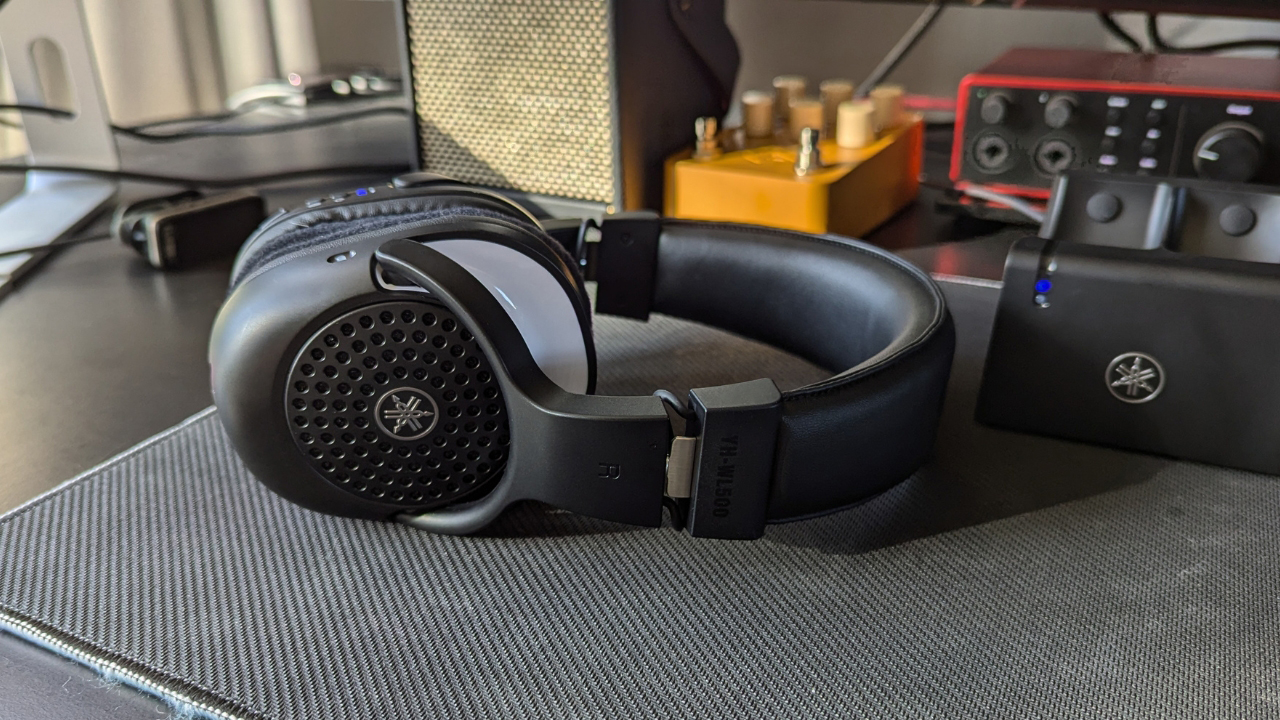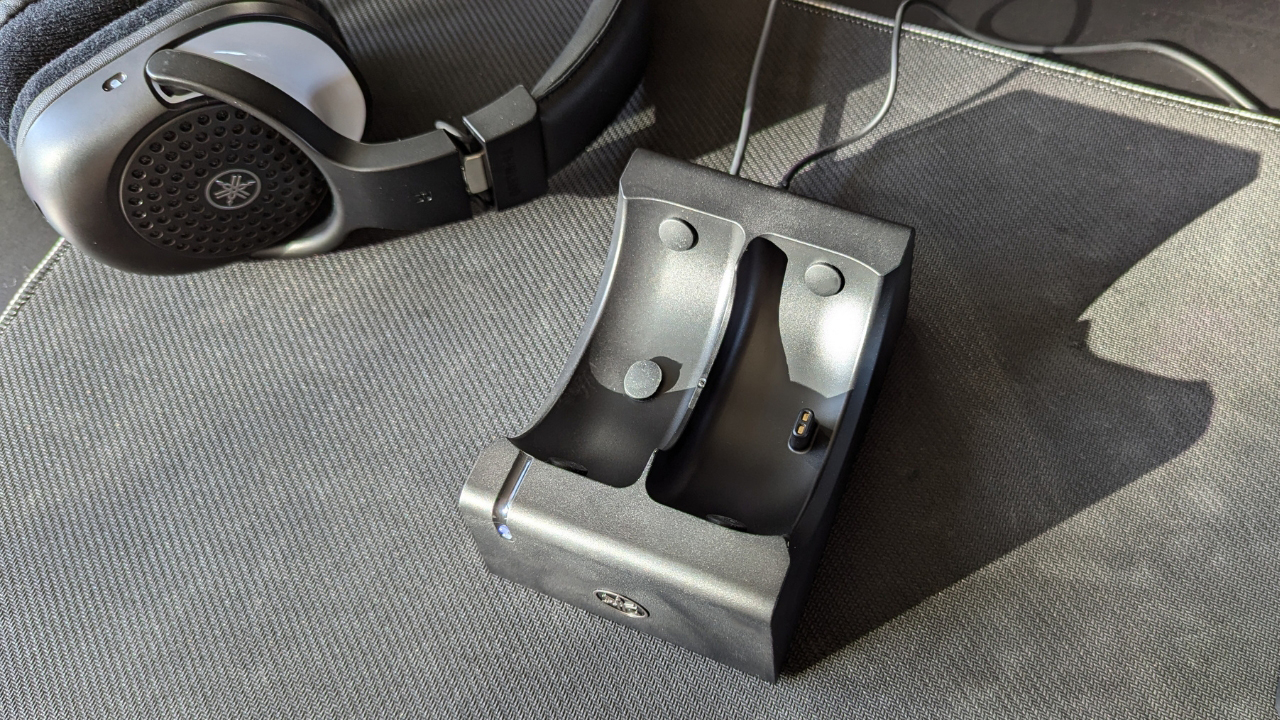Guitar World Verdict
Boasting comfortably better performance than any Bluetooth headphone, the Yamaha YH-WL500s are pretty much the only choice you've got if you want to play your instrument latency-free. They do that job brilliantly, but have a few small flaws that prevent a perfect score.
Pros
- +
Great soundstage
- +
Frees you from cables
- +
Comfortable cups
Cons
- -
Headband was uncomfortable
- -
You can buy great wired cans for the same price
You can trust Guitar World
Yamaha YH-WL500: What is it?
Cables are the bane of any musician's life whether it’s your guitar cables getting tangled around your leg or the coiled cable of headphones getting in the way while you’re recording. I’m always looking for ways to minimize the amount of cables I use, and the Yamaha YH-WL500 promises super low latency wireless performance that’s good enough for musicians to play their instruments wirelessly.
Many previous attempts at wireless technology for musicians have come up short, as we need a very short latency to keep us feeling connected to our instrument. If you’ve ever played with higher buffer settings on an audio interface you’ll know what I’m talking about. Bluetooth 5 currently has a latency figure of around 20-40ms, but for musicians, this is too much.
I look for 5-10ms of latency when it comes to nailing a recorded performance. Anything more and you’re going to start getting timing issues. The Yamaha YH-WL500 promises a very impressive wireless performance of less than 4ms, which is intriguing indeed for those musicians who want to lose as many cables as possible. Even if you’re just using wireless for practice, having that ultra-low latency will only help enhance your playing.
Yamaha YH-WL500: Specs

- PRICE: $560/£318
- TYPE: Open-back, circumaural
- FREQUENCY RESPONSE: 20Hz - 20kHz
- IMPEDANCE: N/A
- DRIVER: 40mm
- CONNECTION: Wireless, Bluetooth 4.2
- CONTACT: Yamaha
Yamaha YH-WL500: Build quality

As with most Yamaha products I’ve encountered, the YH WL500s are very well made and feel nice and robust in your hands. The box they come in is huge, with every plug connector known to man which is a nice touch, and as well as the headphones themselves you get a chunky docking station.
The cups are circumaural - which means they go over your ear - and the headphones themselves are all black apart from a shock of white on the top. The padding on the cups is nice and soft, which is a rectangular shape with rounded edges. The padding on the headband isn’t quite as generous and feels a little thin to my hand. Overall, the build is solid, and I can definitely see them putting up with plenty of abuse over time.
On the back of the left cup, you’ve got your controls, including power, Bluetooth, and volume up and down buttons. There’s also a 1/8-inch jack input for using the included wired cable. On the right cup, there’s a single power LED, as well as a connector that charges them when they’re in the dock.
The dock itself is a chunky bit of kit too, and definitely didn’t feel like it was going anywhere sat on my desk. On the front, there are some LED indicators that show you the charge level and whether or not it's connected to something. On the back, there’s a button for pairing the headphones, a 1/8-inch input jack, and a USB-C connector to provide power with the included cable.
Yamaha YH-WL500: Usability

My headphones came with some power but I opted to charge them fully before carrying out any testing. Fitting them into the dock is surprisingly easy, despite looking a little unwieldy at first. They slot in nicely and feel solid sitting there in the chassis. They took about an hour or so to get a full charge, and with that done I set about connecting them to my phone to see how easy the process was.
Like any Bluetooth device, it’s a breeze if you know what you’re doing. It did actually take me a few goes to pair, but I’ll put that down to the fact my phone is also connected to my smartwatch, laptop, Positive Grid Spark Mini amp, wireless Bluetooth adapter for my car, and a myriad of other devices. When the initial hookup was done the headphones confirmed it in a hilariously posh English accent, and I had no problem selecting them from the list on my phone and listening quickly thereafter.
Connecting via Bluetooth is a nice bonus, but ultimately that’s not why you’d be buying these particular headphones. For the true test, I opted to plug the YH WL500s into a Quad Cortex, and then to add some extra latency in the signal chain I hooked up my guitar via the Positive Grid Spark Link wireless guitar system.
It works fantastically well. There was no discernible latency I could hear while playing and no sooner had I confirmed that with a few favorite licks, I was off around the house to see how it performed on the go. Once I’d gotten upstairs to the front bedroom in my two-story house (the dock located at the back of the bottom floor) I began to get crackles as the signal dropped. Of course, this could’ve been down to the Spark Link as much as the headphones.

It turns out that latency-free playing with wireless headphones is possible after all
Ultimately, the YH-WL500s passed their main test with ease. It turns out that latency-free playing with wireless headphones is possible after all. Even with my fastest licks and most syncopated playing I never felt detached from my guitar, the WL500s keeping up their end of the bargain admirably. If you want to practice with wireless headphones, these will do the job much better than any pair of Bluetooth headphones.
I played for a couple of hours to get a good feel for the fit and there are unfortunately a few shortcomings. The headband padding is pretty lightweight, so after an hour or so the top of my head was aching a bit. I’ve had this before with cans so it’s not exclusive to these headphones, but they’re nowhere near as comfortable as my daily drivers, the Beyerdynamic DT990s.
The cushions on the cups feel great and there were no issues there, but they did slip forward if I tilted my head. For reference, I wear a large bike helmet and they’re loose on the tightest setting the adjustable band offers, so it’s not unreasonable to think they may slip on others who have a smaller head. I’d love to see a V2 with these issues amended, because there’s an amazing sense of freedom with these headphones, and the low latency performance is fantastic. They’re just not that comfortable for more than an hour or so of playing.
Yamaha YH-WL500: Sound

For practicing your instrument, the WL500s are absolutely fine. The sound quality is good, albeit not as nice as mixing specific cans. A/Bing them with my Beyerdynamics it was clear my DT990s delivered the superior sound quality. The WL500s are a little veiled and less open, so fine for listening duties but I wouldn’t mix on them.
They’re nicely balanced overall, and there’s not loads of low-end hype which I always appreciate in a headphone. When playing some reference tracks through them I found the quality to be really good, with an impressive soundstage and a great amount of detail in the sound.
Yamaha YH-WL500: Verdict

Combining incredible wireless performance, good sound, and a robust docking station, the Yamaha YH-WL500s are a brilliant choice for the performing musician who doesn’t want cables getting in the way. They sound good, albeit not great, but that sound will be fine for the vast majority of uses.
They are slightly let down by the fit and comfort levels of the headband, but ultimately they are the only current wireless headphones on the market that have a usable latency for playing and performing.
Guitar World verdict: There’s no doubt that the Yamaha YH-WL500s are the best wireless headphones for musicians you can buy right now, despite a few flaws. The sub-5ms latency time makes them perfect for players of all instruments, whether you’re a guitarist or bassist, play electronic drums, or must have a wireless pair of headphones for mixing.
Yamaha YH-WL500: Also try

Boss Waza-Air: $399.99 / £373 / €425
Probably the only other pair of wireless headphones that are usable for guitarists, Boss Waza-Air is essentially a guitar amp you can wear on your ears. They have an amazing soundstage and spatial technology that lets you move your head while the amp sound stays in the same place.
Read more: Boss Waza-Air review
Yamaha YH-WL500: Hands-on videos
Nate Navarro

EytschPi42

Matt is a Junior Deals Writer here at Guitar World. He regularly tests and reviews music gear with a focus on guitars, amps, pedals, modelers, and pretty much anything else guitar-related. Matt worked in music retail for 5 years at Dawsons Music and Northwest Guitars and has written for various music sites including MusicRadar, Guitar Player, Guitar.com, Ultimate Guitar, and Thomann’s t.blog. A regularly gigging guitarist with over 20 years of experience playing live and writing and recording in bands, he's performed everything from jazz to djent, gigging all over the country in more dingy venues than you can shake a drop-tuned guitar at.
“I didn’t think anybody would believe I got it from George Harrison. I figured they’d call me a liar”: Vintage guitar guru Norman Harris names the 5 most memorable guitars that have come through Norman's Rare Guitars
“The musicians, shops, and brands who use Reverb have always been at the center of all that we do”: Reverb has been acquired by two new investors – and will once again become an independently operated company
"A guitarist's ticket to easier home recording": PreSonus Quantum HD 2 review












